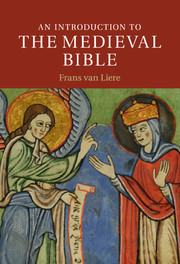Book contents
- Frontmatter
- Dedication
- Contents
- Preface
- Chapter 1 Introduction
- Chapter 2 The Bible as Book
- Chapter 3 The Medieval Canon
- Chapter 4 The Text of the Medieval Bible
- Chapter 5 Medieval Hermeneutics
- Chapter 6 The Commentary Tradition
- Chapter 7 The Vernacular Bible
- Chapter 8 The Bible in Worship and Preaching
- Chapter 9 The Bible of the Poor?
- Afterword
- Appendix A A Comparative Canon Chart
- Appendix B Names for Biblical Books
- Appendix C A Schematic Genealogy of Old Testament Translations
- Bibliography
- Index of Manuscripts Cited
- Index of Biblical References
- Subject and Author Index
- References
Chapter 8 - The Bible in Worship and Preaching
Published online by Cambridge University Press: 05 June 2014
- Frontmatter
- Dedication
- Contents
- Preface
- Chapter 1 Introduction
- Chapter 2 The Bible as Book
- Chapter 3 The Medieval Canon
- Chapter 4 The Text of the Medieval Bible
- Chapter 5 Medieval Hermeneutics
- Chapter 6 The Commentary Tradition
- Chapter 7 The Vernacular Bible
- Chapter 8 The Bible in Worship and Preaching
- Chapter 9 The Bible of the Poor?
- Afterword
- Appendix A A Comparative Canon Chart
- Appendix B Names for Biblical Books
- Appendix C A Schematic Genealogy of Old Testament Translations
- Bibliography
- Index of Manuscripts Cited
- Index of Biblical References
- Subject and Author Index
- References
Summary
Most medieval Christians came to know the Bible not by reading, but by hearing it. It was read aloud in the liturgy of the Church, during Mass and in the prayers of the divine office (the daily liturgical prayer), and during meal times in the monastic refectory. Scripture was also read in prayer, both privately and collectively. Medieval authors quoted the Bible more often from hearing than from a written source, suggesting that medieval Christians, especially monks, had a large memory store of Scripture that resulted from the hours they spent each week reading it aloud. The sources for the liturgical uses of the Bible in the Middle Ages are legion, and they include lectionaries (books that contained selected Bible readings for Mass arranged according to the liturgical calendar) and breviaries (books that contained the text of the daily liturgical prayers of the divine office, for the use of bishops, priests, and deacons who could not always attend the communal prayer). Although collective prayer as a communal practice is well documented from the earliest centuries of Christianity, the sources for private prayer, which included reciting psalms and other Bible readings, are much less forthcoming, at least for the Early Middle Ages. We may suppose that at least some lay people imitated monastic practice by reading Psalms as part of their private devotions. By the thirteenth century, prayer books called Books of Hours had become common among the laity; they elaborated on the “little office of the Virgin Mary,” a number of psalms, canticles, and prayers dedicated to the Virgin Mary, to be prayed at particular times of the day. This “little office” started as a monastic devotion, but it became the daily lay devotion par excellence. People also heard the Bible, at least heard about its contents and stories, through preaching. Both prayer and preaching contributed to the huge resonance that biblical stories and ideas had in medieval society.
- Type
- Chapter
- Information
- An Introduction to the Medieval Bible , pp. 208 - 236Publisher: Cambridge University PressPrint publication year: 2014



